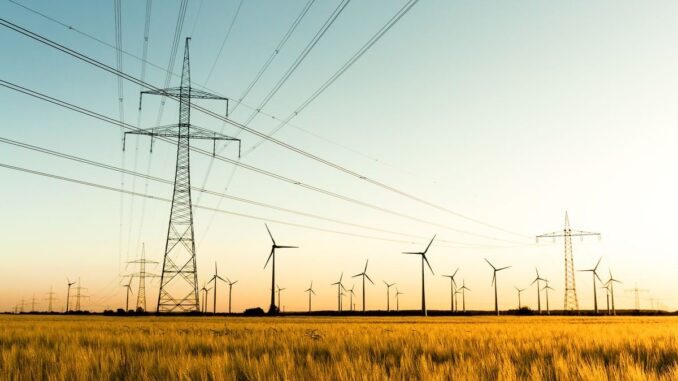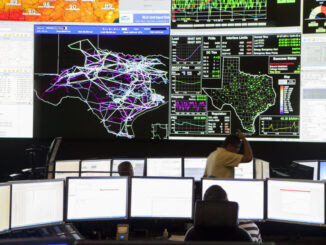
In a landmark decision, the Federal Energy Regulatory Commission in July ordered transmission providers to revise their interconnection rules to help ease a massive backlog of requests by generators and energy storage developers for permission to connect to the grid.
While the new requirements are viewed as a major improvement, the Department of Energy and others are already looking at possible next steps for improving interconnection processes, including “connect and manage,” the interconnection process used by the Electric Reliability Council of Texas.
In her concurrence to FERC’s interconnection rule, Commissioner Allison Clements pointed to connect and manage as a potential template for interconnecting energy-only resources. It was also the focus of Beyond FERC Order 2023: Considerations on Deep Interconnection Reform, a white paper released in August by Tyler Norris, a doctoral student at Duke University and former vice president of development at Cypress Creek Renewables.
Connect and manage is “certainly worth exploring” in any future interconnection action at FERC, Karin Herzfeld, senior transmission counsel to the agency’s acting Chairman Willie Phillips, said at a Nov. 2 meeting hosted by WIRES, a trade group for utilities, grid operators and other companies in the transmission sector.
What is connect and manage?
ERCOT is the only U.S. grid operator to use connect and manage. The Texas grid operator focuses its interconnection request studies on what local upgrades are needed for a project to connect to the grid. In contrast to the rest of the U.S., it doesn’t examine the possible need for broader network upgrades. ERCOT manages any grid bottlenecks caused by a new generator through market redispatch and curtailment.
With roughly 85 GW in peak load, ERCOT is a mid-sized grid operator, but in the last two years leads all U.S. grid operators and transmission providers in interconnecting generation to the grid.
ERCOT brought 14.2 GW online in 2021 and 2022 while in the PJM Interconnection, the largest U.S. grid operator, 5.6 GW started operating during those two years, according to data from S&P Global.
ERCOT brings the most generation online in 2021 and 2022
ERCOT’s approach allows generators to interconnect much more quickly, efficiently and at minimal cost compared with the rest of the United States, according to Norris. Using congestion data, the grid operator relies on a transmission planning process to identify needed transmission upgrades, he said.
In ERCOT, interconnection customers take studies conducted by the grid operator and use them to assess their curtailment risk, according to Norris.
“And then they decide whether or not to proceed, and if they do, they’ll bear that [curtailment] risk,” Norris said. “And of course, we’re seeing many generators deciding they can take that risk.”
In 2022, ERCOT curtailed about 9% of utility-scale solar generation and 5% of wind generation, Norris said in his white paper.
Besides not requiring costly grid upgrades, which can kill planned projects, ERCOT’s interconnection process is faster than elsewhere.
ERCOT’s interconnection process can be finished in one to two years, according to Frank Swigonski, Pine Gate Renewables’ director of market design.
“We’re big fans of connect and manage,” he said, adding that interconnection issues are the company’s “number one project killer.”
It takes roughly 3.5 years to complete ERCOT’s interconnection process and bring a project online, compared to six or more years in other regions, with PJM and the Southwest Power Pool the longest, according to Mario Hayden, Enel North America director of transmission.
“In ERCOT, it’s been fairly plug and play,” he said.
Enel has 3.3 GW of wind and solar capacity in ERCOT, plus 520 MW of energy storage that can provide 780 MWh before recharging. It is building 1.8 GW of solar and 823 MW/1,234 MWh of utility-scale storage in ERCOT, which covers most of Texas.
Invest and connect
Outside ERCOT, transmission owners and grid operators use an “invest and connect” interconnection framework. They generally study interconnection requests for “network resource interconnection service,” or NRIS, to see whether broad transmission upgrades are needed under stressed conditions to reliably bring planned power plants and storage facilities online at full capacity. Generators then pay for any needed network upgrades, which are made before they connect to the grid.
The process has grown longer and more expensive, according to a June report by the Lawrence Berkeley National Laboratory. The average interconnection costs for projects in PJM’s interconnection queue jumped eightfold to $240/kW in the 2020 to 2022 period from $29/kW in the previous two years, Berkeley Lab researchers said in a January report.
The pace of the interconnection process has resource adequacy implications, according to Swigonski. In PJM, for example, the interconnection process has been so bogged down, it would be difficult for generators to respond to price signals in its capacity market, he said.
“If you were to try to start building a new power plant today [based on rising capacity prices,] you’re looking at at least five years before the power plant is going to become operational,” Swigonski said.
Lessons from ERCOT
ERCOT offers lessons for interconnection reform elsewhere in the United States, according to Norris.
“ERCOT’s interconnection performance suggests that less restrictive study approaches and greater use of real-time congestion management could enable more efficient use of limited transmission capacity,” he said. “The goal is to figure out how to improve energy-only and fast-track options and to depend less on the interconnection study process to identify and fund network upgrades.”
Given ERCOT’s attributes — it’s an energy-only, single-state market without broad cost allocation for interconnection costs — it would be difficult to directly transfer the Texas framework to other markets, according to Enel’s Hayden.
One potential option is to enhance FERC’s requirement that transmission providers offer “energy resource interconnection service,” or ERIS, for energy-only resources that doesn’t require full deliverability under stressed grid conditions, Norris said. If a project qualifies for ERIS, its potential grid upgrade costs could be significantly lower than if its developer sought NRIS interconnection, he said. The generator, however, faces curtailment risks.
In her concurrence to FERC’s interconnection rule, Clements said ERCOT could provide a template for ERIS interconnection. Streamlining ERIS interconnection assessment could allow transmission providers to focus their study resources on a smaller number of requests seeking NRIS, she said.
Some reform options include studying clustered interconnection requests in two steps: first ERIS requests, followed by NRIS requests, according to Norris’s white paper. And instead of studying ERIS requests using power flows, transmission providers could study them using “security constrained economic dispatch,” which could identify whether curtailment could handle grid constraints caused by the project, he said.
Overall, if energy-only and other fast-track interconnection options become more attractive, that could reduce the volume of projects seeking NRIS, improving the efficiency and success rate of the interconnection study process broadly, Norris said.
Operational, planning concerns
However, the connect and manage approach raises operational and planning issues, according to Casey Cathey, SPP senior director for grid asset utilization.
On the operation side, markets, which would be used to manage the “connect and manage” resources, cannot assess operating issues such as voltage stability, transient stability, short circuit challenges and critical clearing time challenges, Cathey said.
“When you talk about the concept of connect and manage, there’s this whole area of electrical engineering that still needs to be addressed,” he said.
Also, connect and manage would need to be coupled with transmission planning reforms that assess future transmission needs to make sure grid planners are “looking at the robust transmission solutions associated with what’s necessary to best process all these [generator interconnection] requests,” Cathey said.
Generally, the goal of connect and manage is to more quickly add power supplies to the grid, Cathey said. But if grid operators aren’t identifying transmission upgrades during the generator interconnection process, and ultimately more transmission is needed, power plant owners may face significant curtailment until more transmission is built, which can take years, according to Cathey.
“Then the question is, what have we really done?” he said.
ENB Top News
ENB
Energy Dashboard
ENB Podcast
ENB Substack



